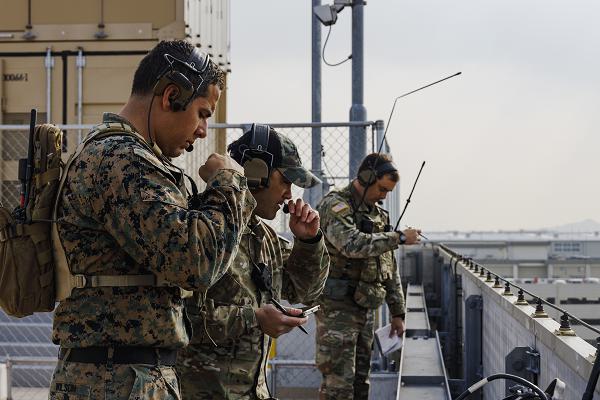
Marine Corps Air Station, Iwakuni, Japan. (May 2, 2024): As jet aircraft streak across the sky to provide close air support, troops on the ground depend on the skills of a Joint Terminal Attack Controller (JTAC) to avoid friendly fire. In this photo by Lance Corporal Brienna Tuck, Staff Sergeant Joshua Wilson, front, a joint terminal attack controller instructor with 5th Air Naval Gunfire Liaison Company, III Marine Expeditionary Force Information Group, along with Army Special Forces operators with 1st Special Forces Group, conduct simulated close air support for troops on the ground. The JTACs carefully coordinate conversations between pilots and forces on the ground to allow for targeting the enemy while avoiding friendly casualties.
The 5th Air Naval Gunfire Liaison Company (ANGLICO) is an airborne fire support unit best known for their ability to coordinate land and sea-based artillery, rockets, and naval gunfire in support of troops on the ground. These units specialize in combined arms and are experts at planning, coordinating, and delivering close air fires.
ANGLICOs date back to World War II where the American island-hopping strategy revealed a severe need to coordinate air, naval and artillery gunfire support between the Marines, Navy, Army, and other Allied forces. Today, ANGLICOs support Marine task forces around the globe.
An important distinction must be made between JTACs and Forward Air Controllers or FACs. The FACs are aviators who help plan ground operations and conduct liaison with aviation units. The JTACs, by contrast, have a ground combat arms background in addition to the ability to direct combat aircraft engaged in offensive air support operations.
In addition to their primary MOS training. JTACs are experts at artillery fire support, field radio operations, direct air support operations, and naval gunfire spotting. They receive airborne training and are jump qualified and they undergo advanced training in escape and evasion, fieldcraft, and a variety of insertion methods.
These highly trained warfighters use these skills to save the lives of troops on the ground.


